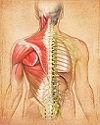Frequently asked questions (FAQ):
What Is Osteopathy?
Osteopathy focuses on total body. It's science is based on knowledge of the anatomy, physiology, and biomechanics and their interrelationship in the organism. Its aim is to liberate the tissues from their restrictions in order to help their normal mobility.
Dr. Andrew Taylor Still, a surgeon, established the practice of Osteopathy in 1874 in the United States of America, with the aim of using manual 'hands on' techniques to improve circulation and correct altered biomechanics. Osteopaths are part of a multidisciplary healthcare team in the United States for over 120 years.
In Canada the College d'Etudes Osteopathiques (CEO) was founded in 1981. Canadian osteopaths are not medical doctors. Quebec University graduates in a health related field, such as physiotherapy, athletic therapy, nursing are accepted into an osteopathy program that includes a minimum of 5 years of clinical and academic study in osteopathic manual practice and a research thesis. The program is taught in Montreal by Canadian and European osteopaths. An osteopath who is a member of Osteopathie Quebec meets the criteria set out by the World Health Organization (WHO).
How is it different to other disciplines? What are the qualities of Osteopaths?
One of the key principles are based on all parts of the body functioning together in an integrated manner. If one part of the body is restricted, then the rest of the body must adapt and compensate for this, eventually leading stiffness and restrictions. When the body is free of restrictions in movement, better mobility provides the body with the opportunity to move freely.
Osteopaths use a broad range of gentle hands-on techniques including soft tissue stretching, deep tactile pressure, and mobilisation of structures.
Is there any other important information?
All major insurance companies recognise Osteopathy under their paramedical coverage.
What is Athletic Therapy
In Canada, a certified athletic therapist (CAT(C)) is a health care practitioner skilled in the prevention, identification, intervention, management and treatment of emergency, acute and chronic musculoskeletal conditions and injuries to the physically active sustained either at work or through involvement in recreational or sporting activities.
A certified athletic therapist optimizes the ability of professional and amateur athletes, or any active individual to perform at their best through sport specific training, injury prevention and rehabilitation for rapid return to work or play. The same techniques used by a certified athletic therapist help him to treat effectively the musculoskeletal afflictions of Quebec’s active population.
Becoming an Athletic Therapist
Step 1: One must enroll and complete an accredited Athletic Therapy curriculum offered in one of the 8 accredited post-secondary institutions across Canada.
In Quebec, Concordia University, in Montreal, and the Université du Québec à Trois-Rivières (UQTR) each offer a valid academic curriculum. Concordia University offers a Bachelor of Science degree in Exercise Science with a Specialization in Athletic Therapy a DESS in Athletic Therapy. This program is a four-year undergraduate degree program taught in English. UQTR offers a one-year DESS in Athletic Therapy in French. However, candidates willing to apply to the DESS must be graduated from the UQTR Kinesiology undergrad program.
The students receive intensive practical and theoretical training in:
- assessment, treatment and management of musculoskeletal conditions
- emergency care and first responder skills
- injury prevention and prophylactic support techniques
- strength and conditioning
- therapeutic electrical modalities
- human anatomy and physiology
- exercise physiology
- biomechanics
- nutrition
- statistics and research design
Although the faculties and composition may vary across accredited institutions and provinces, the curriculum remains the same and is enforced by the Program Accreditation Committee of the Canadian Athletic Therapists Association.
Step 2: Complete the Sports First Responder Course.
Step 3: Pass the National Certification Exam
Once a student completes their degree program and received their Sports First Responder Certification, the candidate is eligible to apply to attempt the National Certification exam, developed and administered by the Certification Board of the Canadian Athletic Therapists Association.
The exam process is one of the most stringent in the Canadian healthcare system. The exam is a theoretical examination process.
Upon successful completion of the exam, the certification candidate becomes a certified athletic therapist who is a member of the CTSQ and the CATA.
To remain a practicing member in good standing within these associations, each certified member must maintain a valid CPR and/or Sports First Responder certification, pay their annual membership dues, and advance their skillsets by participating in various continuing education opportunities on a regular basis.
Additional info:
Association Ostéopathie Québec
Canadian Athletic Therapists Association (CATA)
